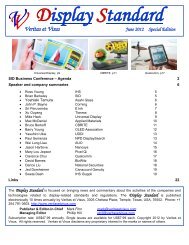Create successful ePaper yourself
Turn your PDF publications into a flip-book with our unique Google optimized e-Paper software.
<strong>Veritas</strong> <strong>et</strong> <strong>Visus</strong> <strong>Display</strong> <strong>Standard</strong> February 2009<br />
ORA releases software for complex optical systems<br />
CODE V, the premier optical design software from Optical Research Associates (ORA), now delivers faster<br />
optimization of complex optical systems by taking full advantage of parallel processing on multi-core architecture<br />
CPUs. In particular, both of its local and global optimization routines in the release of CODE V 10.0 are now<br />
enabled for multi-core operation. Optical designers can solve the most complex lens design problems in a fraction<br />
of the time needed using a single processor. CODE V 10.0 also offers improved accuracy and ease of use for<br />
diffraction analysis. Its new “Beam Synthesis Propagation” (BSP) feature uses a beaml<strong>et</strong>-based, diffraction<br />
propagation algorithm to include diffraction effects through the entire optical system design. BSP delivers greater<br />
accuracy than using exit-pupil diffraction computations, or beam propagation based on FFT or angular spectrum<br />
m<strong>et</strong>hods. Systems with astigmatic beams, polarized input optical fields, low f-numbers (e.g., microlithography<br />
lenses), or non-contiguous pupils are accurately analyzed with<br />
BSP. The feature is also useful for near-field diffraction<br />
analysis and for optical systems where the amplitude or phase<br />
is modified near the focus, such as with a grating, phase plate,<br />
or spatial filter. D<strong>et</strong>ermining appropriate inputs for any beam<br />
propagation algorithm can be challenging, but BSP solves this<br />
by including a unique pre-analysis feature, which<br />
automatically provides appropriate input recommendations for<br />
a specific lens system, including input field sampling,<br />
resampling and output grid characteristics. Using pre-analysis,<br />
BSP will also estimate an execution run time for a lens<br />
system. http://www.opticalres.com<br />
Tektronix picture quality analyzer assists SureWest Communications in evaluation of H.264 encoders<br />
Tektronix announced that SureWest Communications, which provides advanced digital TV, high-speed Intern<strong>et</strong><br />
and telephone services to the greater Sacramento and Kansas City regions, used the Tektronix PQA500 picture<br />
quality analysis tool in its Sacramento mark<strong>et</strong> to provide dependable evaluation and qualification of H.264 video<br />
encoders intended for future deployment in their digital television service. As more broadcasters move to high<br />
definition (HD) output, it is imperative that their new and existing equipment is capable of supporting the highest<br />
quality images. Broadcasters need to accurately and comprehensively assess the picture quality of encoding and<br />
decoding equipment so they can have confidence that it me<strong>et</strong>s or exceeds their requirements. By using an algorithm<br />
that accurately models the human vision system, the Tektronix PQA500 provides a suite of repeatable, objective<br />
quality measurements that closely correspond with subjective human visual assessment. These measurements<br />
provide valuable information to engineers working to optimize video compression and recovery, and maintain a<br />
level of common carrier and distribution transmission service to clients and viewers. http://www.tektronix.com<br />
Ocean Thin Films releases ColorBug wireless color and luminance testing device<br />
Ocean Thin Films, a division of Ocean Optics, introduced the<br />
ColorBug handheld wireless device for lighting designers,<br />
technicians, videographers and digital photographers.<br />
ColorBug measures CIE color values and luminance in<br />
theatrical, studio and architectural applications. Its software<br />
allows technicians to wirelessly share data with their iPhone<br />
or iPod touch, making color analysis simple and convenient.<br />
The ColorBug can be mounted on walls and other fixtures to<br />
assist in taking measurements remotely or hands-free. Smaller<br />
than a typical mobile phone, ColorBug is compl<strong>et</strong>ely portable<br />
and features a rechargeable lithium-ion battery, and mini USB<br />
connectivity. http://www.seachangeronline.com/colorbug.html<br />
76






